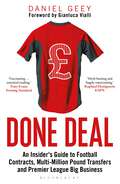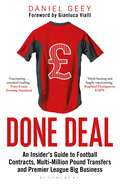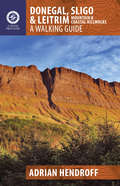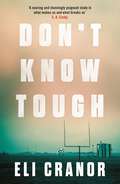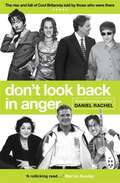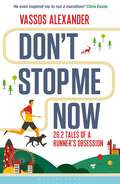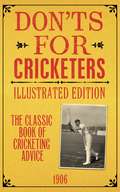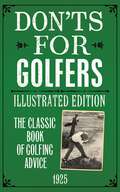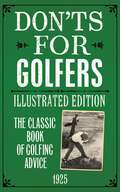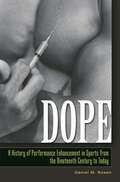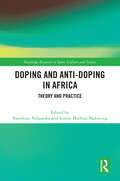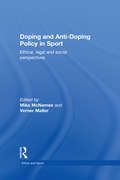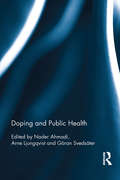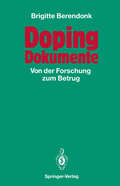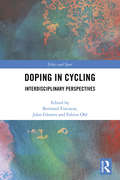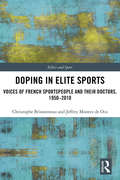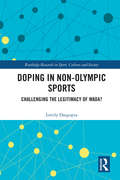- Table View
- List View
Done Deal: An Insider's Guide to Football Contracts, Multi-Million Pound Transfers and Premier League Big Business
by Daniel GeeyInsightful, enlightening and thought-provoking, leading Premier League lawyer Daniel Geey lifts the lid on the inner workings of modern football. Whether it is a manager being sacked, the signing of a new star player, television rights negotiations, player misconduct or multi-million-pound club takeovers, lawyers remain at the heart of all football business dealings. Written by leading Premier League lawyer Daniel Geey, who has dealt with all these incidents first hand, this highly accessible book explores the issues – from pitch to boardroom – that shape the modern game and how these impact leagues, clubs, players and fans.Featuring insider anecdotes and expert contributions, Done Deal provides football fans with a fresh and authoritative perspective on all off-field football matters.
Done Deal: An Insider's Guide to Football Contracts, Multi-Million Pound Transfers and Premier League Big Business
by Daniel GeeyInsightful, enlightening and thought-provoking, leading Premier League lawyer Daniel Geey lifts the lid on the inner workings of modern football. Whether it is a manager being sacked, the signing of a new star player, television rights negotiations, player misconduct or multi-million-pound club takeovers, lawyers remain at the heart of all football business dealings. Written by leading Premier League lawyer Daniel Geey, who has dealt with all these incidents first hand, this highly accessible book explores the issues – from pitch to boardroom – that shape the modern game and how these impact leagues, clubs, players and fans.Featuring insider anecdotes and expert contributions, Done Deal provides football fans with a fresh and authoritative perspective on all off-field football matters.
Donegal, Sligo & Leitrim: A Walking Guide (A Walking Guide)
by Adrian HendroffThe northwest of Ireland provides a diversity of walks, from the wild, untamed landscape of Donegal to the gentler hills and green valleys of Sligo and Leitrim. This guidebook describes 27 walks of various grades, accompanied by quality photographs and specially drawn maps. Walk descriptions also include material on the rich natural history, folklore, geology and place names of the area. Since most routes are not signposted or waymarked, an up-to-date guidebook is essential. This will inspire you to get your walking boots on and start exploring this majestic landscape. • Also by this author: 'The Dingle Peninsula: A Walking Guide' and 'The Beara & Sheep's Head Peninsulas: A Walking Guide'. For a complete list of walking guides available from The Collins Press, see www.collinspress.ie
Don't Know Tough: 'Southern noir at its finest' NEW YORK TIMES
by Eli Cranor'A searing and stunningly poignant study in what makes us and what breaks us' S. A. Cosby, New York Times bestselling author of Razorblade Tears and Blacktop Wasteland'A gripping novel about rage and trauma, redemption and damnation, football and family' Steph ChaFriday Night Lights with a Southern Gothic twist - a powerful debut noir for fans of S. A. Cosby and Megan Abbott.In Denton, Arkansas, the fate of the high school football team rests on the shoulders of Billy Lowe, a volatile but talented running back. Billy comes from an extremely troubled home: a trailer park where he is terrorized by his unstable mother's abusive boyfriend. Billy takes out his anger on the field, but when his savagery crosses a line, he faces suspension.Without Billy Lowe, the Denton Pirates can kiss their playoff bid goodbye. But the head coach, Trent Powers, who just moved from California with his wife and two children for this job, has more than just his paycheck riding on Billy's bad behavior. As a born-again Christian, Trent feels a divine calling to save Billy-save him from his circumstances, and save his soul.Then Billy's abuser is found murdered in the Lowe family trailer, and all evidence points toward Billy. Now nothing can stop an explosive chain of violence that could tear the whole town apart on the eve of the playoffs.WINNER OF THE PETER LOVESEY FIRST CRIME NOVEL CONTEST A USA Today Best Book of the Year (So Far)An Amazon Editor's PickCrimeReads Most Anticipated Books of 2022New York Post Top Reads for the Week'Southern noir at its finest, a cauldron of terrible choices and even more terrible outcomes' The New York Times Book Review
Don't Look Back In Anger: The rise and fall of Cool Britannia, told by those who were there
by Daniel RachelThe nineties was the decade when British culture reclaimed its position at the artistic centre of the world. Not since the 'Swinging Sixties' had art, comedy, fashion, film, football, literature and music interwoven into a blooming of national self-confidence. It was the decade of Lad Culture and Girl Power; of Blur vs Oasis. When fashion runways shone with British talent, Young British Artists became household names, football was 'coming home' and British film went worldwide. From Old Labour's defeat in 1992 through to New Labour's historic landslide in 1997, Don't Look Back In Anger chronicles the Cool Britannia age when the country united through a resurgence of patriotism and a celebration of all things British. But it was also an era of false promises and misplaced trust, when the weight of substance was based on the airlessness of branding, spin and the first stirrings of celebrity culture. A decade that started with hope then ended with the death of the 'people's princess' and 9/11 - an event that redefined a new world order. Through sixty-eight voices that epitomise the decade - including Tony Blair, John Major, Noel Gallagher, Damon Albarn, Tracey Emin, Keith Allen, Meera Syal, David Baddiel, Irvine Welsh and Steve Coogan - we re-live the epic highs and crashing lows of one of the most eventful periods in British history. Today, in an age where identity dominates the national agenda, Don't Look Back In Anger is a necessary and compelling historical document.
Don't Stop Me Now: 26.2 Tales of a Runner’s Obsession
by Mr Vassos Alexander Chris EvansThis is a celebration of running - and what lots of us think about when we run. Part escape, part self-discovery, part therapy, part fitness. Part simple childlike joy of running when you could be walking.Vassos Alexander shares the highs and lows of falling in love with running, from his first paltry efforts to reach the end of his street to completing ultra marathons and triathlons in the same weekend. Each of the 26.2 chapters also features a fascinating insight into how others first started – from Paula Radcliffe to Steve Cram, the Brownlees to Jenson Button, Nicky Campbell to Nell McAndrew. Also includes a foreword by Chris Evans.Funny, inspiring, honest - the perfect read for anyone with well-worn trainers by the door (or thinking of buying a pair...)
Don't Stop Me Now: 26.2 Tales of a Runner’s Obsession
by Vassos Alexander Chris EvansThis is a celebration of running - and what lots of us think about when we run. Part escape, part self-discovery, part therapy, part fitness. Part simple childlike joy of running when you could be walking.Vassos Alexander shares the highs and lows of falling in love with running, from his first paltry efforts to reach the end of his street to completing ultra marathons and triathlons in the same weekend. Each of the 26.2 chapters also features a fascinating insight into how others first started – from Paula Radcliffe to Steve Cram, the Brownlees to Jenson Button, Nicky Campbell to Nell McAndrew.Funny, inspiring, honest - the perfect read for anyone with well-worn trainers by the door (or thinking of buying a pair...)
Don'ts for Cricketers: Illustrated Edition
by Derek PringleA new illustrated edition of the classic book of cricketing advice.Foreword by former England Test cricketer and bestselling author Derek Pringle.The advice found in Don'ts for Cricketers was originally printed in 1906 and contains hundreds of snippets of entertaining, timeless and amusing advice for cricketers of all abilities. The content, ranging from technique and equipment to etiquette on the field, provides a fascinating snapshot of life in early twentieth-century Britain. Advice includes: 'Don't be in two minds about how you are going to play the ball, for that way madness lies.''Don't be sulky or sad if your bowling is punished or your captain takes you off bowling when you want to continue.''Don't forget the motto of that famous old cricket club, I Zingari: "Keep your promise, keep your temper, keep your wicket up.”'
Don'ts for Cricketers: Illustrated Edition
by Bloomsbury PublishingA new illustrated edition of the classic book of cricketing advice.Foreword by former England Test cricketer and bestselling author Derek Pringle.The advice found in Don'ts for Cricketers was originally printed in 1906 and contains hundreds of snippets of entertaining, timeless and amusing advice for cricketers of all abilities. The content, ranging from technique and equipment to etiquette on the field, provides a fascinating snapshot of life in early twentieth-century Britain. Advice includes: 'Don't be in two minds about how you are going to play the ball, for that way madness lies.''Don't be sulky or sad if your bowling is punished or your captain takes you off bowling when you want to continue.''Don't forget the motto of that famous old cricket club, I Zingari: "Keep your promise, keep your temper, keep your wicket up.”'
Don'ts for Golfers: Illustrated Edition (Don'ts Ser.)
by Sandy GreenA new illustrated edition of the classic book of golf advice first published in 1925. Foreword by Masters and Ryder Cup legend Ian Woosnam.The advice found in Don'ts for Golfers was originally printed in 1925 and contains hundreds of snippets of entertaining, timeless and amusing advice for golfers of all abilities. The content, ranging from technique and equipment to etiquette on the course, provides a fascinating snapshot of life in early twentieth-century Britain.Advice includes: 'Don't irritate your opponent by wearing jazzy colours. To dazzle his eyes with a multi-coloured pull-over or peace-disturbing golf stockings is to take a mean advantage.''Don't blame your clubs for faults of your own that may be easily corrected if you analyze your methods of using the implements.''Don't over-indulge yourself in eating and drinking during the non-golfing days, and then expect to work off excess by "a good game of Golf." You may play Golf of sorts, but it will not be a good game.''Don't make Golf your sole topic of conversation. There are a few otherwise quite intelligent persons who are non-golfers. You will never make converts if you bore non-players to distraction by for ever talking of the Royal and Ancient Game.'
Don'ts for Golfers: Illustrated Edition
A new illustrated edition of the classic book of golf advice first published in 1925.Foreword by Masters and Ryder Cup legend Ian Woosnam.The advice found in Don'ts for Golfers was originally printed in 1925 and contains hundreds of snippets of entertaining, timeless and amusing advice for golfers of all abilities. The content, ranging from technique and equipment to etiquette on the course, provides a fascinating snapshot of life in early twentieth-century Britain.Advice includes:'Don't irritate your opponent by wearing jazzy colours. To dazzle his eyes with a multi-coloured pull-over or peace-disturbing golf stockings is to take a mean advantage.''Don't blame your clubs for faults of your own that may be easily corrected if you analyze your methods of using the implements.''Don't over-indulge yourself in eating and drinking during the non-golfing days, and then expect to work off excess by "a good game of Golf." You may play Golf of sorts, but it will not be a good game.''Don't make Golf your sole topic of conversation. There are a few otherwise quite intelligent persons who are non-golfers. You will never make converts if you bore non-players to distraction by for ever talking of the Royal and Ancient Game.'
Don'ts for Golfers: Illustrated Edition
A new illustrated edition of the classic book of golf advice first published in 1925.Foreword by Masters and Ryder Cup legend Ian Woosnam.The advice found in Don'ts for Golfers was originally printed in 1925 and contains hundreds of snippets of entertaining, timeless and amusing advice for golfers of all abilities. The content, ranging from technique and equipment to etiquette on the course, provides a fascinating snapshot of life in early twentieth-century Britain.Advice includes:'Don't irritate your opponent by wearing jazzy colours. To dazzle his eyes with a multi-coloured pull-over or peace-disturbing golf stockings is to take a mean advantage.''Don't blame your clubs for faults of your own that may be easily corrected if you analyze your methods of using the implements.''Don't over-indulge yourself in eating and drinking during the non-golfing days, and then expect to work off excess by "a good game of Golf." You may play Golf of sorts, but it will not be a good game.''Don't make Golf your sole topic of conversation. There are a few otherwise quite intelligent persons who are non-golfers. You will never make converts if you bore non-players to distraction by for ever talking of the Royal and Ancient Game.'
Dope: A History of Performance Enhancement in Sports from the Nineteenth Century to Today
by Daniel M. RosenSince the dawn of athletic competition during the original Olympic Games in Ancient Greece, athletes, as well as their coaches and trainers, have been finding innovative ways to gain an edge on their competition. Some of those performance-enhancement methods have been within the accepted rules while other methods skirt the gray area between being within the rules and not, while still other methods break the established rules. In modern times, doping - the use of performance-enhancing drugs - has been one method athletes and their trainers have used to beat their competition. The history of sports doping during the modern era can be traced through the events and scandals of the times in which the athletes lived. From the use of amphetamines and other stimulants in the early 20th century, to the use of testosterone and steroids by both the USSR and the United States during Cold War-era Olympics games, to blood doping and EPO, to designer drugs, the history of doping in sports closely follows the medical and technological advances of our times. In the early 21st century, the possibility of genetically engineered athletes looms. The story of doping in sports over the last century offers clues to where the battle over performance enhancement will be fought in the years to come.
Doping and Anti-Doping in Africa: Theory and Practice (Routledge Research in Sport, Culture and Society)
by Yamikani Ndasauka Simon Mathias MakwinjaThis is the first book to focus on the problem of performance-enhancing substances and methods - also known as doping - in sports from African perspectives. Placing traditional African thinking and indigenous knowledge systems at the centre of the analysis, the book shines new light on the distinctive characteristics of African sporting cultures, doping practices, the management of anti-doping, and new methods for preventing doping in sports that take into account African value systems. The book draws on multi-disciplinary work from philosophy, ethics, sociology, history and political science, and presents real world case studies of doping and anti-doping from across the African continent. It explores key themes and sites in African sport, culture and society, including African art, traditional medicine, attitudes towards doping in Africa, sport policy, education systems, media and communications, and the problem of privacy in African sports. The book also considers the uniquely African challenges in anti-doping against the background of WADA policy and practice, and wider international anti-doping efforts. This book is fascinating reading for students and researchers with an interest in sport studies, African studies, crime and deviance or public policy, and for sports administrators, sports policy makers or practitioners working in international, national or regional sports organisations.
Doping and Anti-Doping in Africa: Theory and Practice (Routledge Research in Sport, Culture and Society)
This is the first book to focus on the problem of performance-enhancing substances and methods - also known as doping - in sports from African perspectives. Placing traditional African thinking and indigenous knowledge systems at the centre of the analysis, the book shines new light on the distinctive characteristics of African sporting cultures, doping practices, the management of anti-doping, and new methods for preventing doping in sports that take into account African value systems. The book draws on multi-disciplinary work from philosophy, ethics, sociology, history and political science, and presents real world case studies of doping and anti-doping from across the African continent. It explores key themes and sites in African sport, culture and society, including African art, traditional medicine, attitudes towards doping in Africa, sport policy, education systems, media and communications, and the problem of privacy in African sports. The book also considers the uniquely African challenges in anti-doping against the background of WADA policy and practice, and wider international anti-doping efforts. This book is fascinating reading for students and researchers with an interest in sport studies, African studies, crime and deviance or public policy, and for sports administrators, sports policy makers or practitioners working in international, national or regional sports organisations.
Doping and Anti-Doping Policy in Sport: Ethical, Legal and Social Perspectives (Ethics and Sport)
by Mike McNamee Verner MøllerThe issue of doping has been the most widely discussed problem in sports ethics and is one of the most prominent issues across sports studies, the sports sciences and their constituent disciplines. This book adds uniquely to that catalogue of discourses by focusing on extant anti-doping policy and doping practices from a range of multi-disciplinary perspectives (specifically ethical, legal, and social scientific). With contributions from a world-class team of scholars and legal practitioners from the UK, Europe and North America, the book explores key contemporary issues such as: sports medicine international doping policy the whereabouts system the criminalization of doping privacy rights, gene doping and ethics imperfection in doping test procedures steroid use in the general population. Doping and Anti-Doping Policy in Sport offers an important critique of contemporary anti-doping policy and is essential reading for any advanced student, researcher or policy maker with an interest in this vital issue.
Doping and Anti-Doping Policy in Sport: Ethical, Legal and Social Perspectives (Ethics and Sport)
by Mike McNamee and Verner MøllerThe issue of doping has been the most widely discussed problem in sports ethics and is one of the most prominent issues across sports studies, the sports sciences and their constituent disciplines. This book adds uniquely to that catalogue of discourses by focusing on extant anti-doping policy and doping practices from a range of multi-disciplinary perspectives (specifically ethical, legal, and social scientific). With contributions from a world-class team of scholars and legal practitioners from the UK, Europe and North America, the book explores key contemporary issues such as: sports medicine international doping policy the whereabouts system the criminalization of doping privacy rights, gene doping and ethics imperfection in doping test procedures steroid use in the general population. Doping and Anti-Doping Policy in Sport offers an important critique of contemporary anti-doping policy and is essential reading for any advanced student, researcher or policy maker with an interest in this vital issue.
Doping and Public Health
by Nader Ahmadi Arne Ljungqvist Göran SvedsäterDoping – the use of performance-enhancing substances and methods – has long been a high-profile issue in sport but in recent years it has also become an issue in wider society. This important new book examines doping as a public health issue, drawing on a multi-disciplinary set of perspectives to explore the prevalence, significance and consequences of doping in wider society. It introduces the epidemiology of doping, examines the historical context, and explores the social, behavioural, legal, ethical and political aspects of doping. The book also discusses possible interventions for addressing the problem on organisational and societal levels. Doping and Public Health incorporates the latest research to provide a comprehensive guide to the key aspects of doping as a social phenomenon. Divided into six parts, this collection of studies offers detailed insight into: ideals of health and fitness in today’s society reasons behind the use of doping medical and social consequences of doping the importance of a doping-free society challenges to the detection and prevention of doping the global anti-doping movement. This book is a valuable resource for sport students, instructors and sport professionals, and will also be of interest to educators and policy-makers working in the areas of health, criminology, sociology and law.
Doping and Public Health
by Nader Ahmadi Arne Ljungqvist Göran SvedsäterDoping – the use of performance-enhancing substances and methods – has long been a high-profile issue in sport but in recent years it has also become an issue in wider society. This important new book examines doping as a public health issue, drawing on a multi-disciplinary set of perspectives to explore the prevalence, significance and consequences of doping in wider society. It introduces the epidemiology of doping, examines the historical context, and explores the social, behavioural, legal, ethical and political aspects of doping. The book also discusses possible interventions for addressing the problem on organisational and societal levels. Doping and Public Health incorporates the latest research to provide a comprehensive guide to the key aspects of doping as a social phenomenon. Divided into six parts, this collection of studies offers detailed insight into: ideals of health and fitness in today’s society reasons behind the use of doping medical and social consequences of doping the importance of a doping-free society challenges to the detection and prevention of doping the global anti-doping movement. This book is a valuable resource for sport students, instructors and sport professionals, and will also be of interest to educators and policy-makers working in the areas of health, criminology, sociology and law.
Doping Dokumente: Von der Forschung zum Betrug
by Brigitte BerendonkGeahnt und befürchtet hatten die Sportbegeisterten und -zuschauer schon seit langem, daß im Leistungssport gedopt wird. Trotz gelegentlicher Selbstbekenntnisse von Sportlern aber wurde dies von offizieller Seite stets bestritten und Vermutungen als bösartig und falsch abgetan. Noch bestand Hoffnung, daß Fairness und natürliche Freude am Wettkampf im Spitzensport ausschlaggebend sei. Erst als sich deutliche Hinweise - u.a. Ben Johnson in Seoul - nicht mehr abstreiten ließen, fanden in den USA, in Canada und Australien offizielle Untersuchungen statt. Bei den dabei unter Eid gemachten Aussagen von Sportlern, Trainern, Sportmedizinern und Funktionären kam das ungeheure Ausmaß des Dopingmißbrauchs langsam ans Tageslicht. Auch in der Bundesrepublik wurde eine Kommission eingesetzt, deren nun vorliegender Bericht zeigt, daß zumindest in der ehemaligen DDR flächendeckend gedopt wurde. Die offizielle Empfehlung lautet allerdings: keinen Schuldigen nennen, schweigen - und schweigend weiterdopen, um auch bei den nächsten internationalen Sportfesten glänzen zu können. Ohne die genauen Fakten und Namen der Verantwortlichen und Mittäter zu nennen, wird es aber keine Reinigung des Sports vom Doping und keine Zukunft für einen menschenwürdigen Leistungssport geben. Noch gelten die Anabolika-unterstützten Rekorde als Vorgaben. Deshalb und besonders auch der zahlreichen Opfer wegen - der ohne ihr Wissen mit Hormonen behandelten oft jugendlichen Sportler auf der einen Seite sowie derjenigen, die vergeblich versucht hatten, auf faire Art sportliche Leistungen zu erbringen - hat sich die Autorin entschlossen, mit diesem Buch die Wahrheit an die Öffentlichkeit zu bringen. Dokumentiert wird auch, welche gesundheitlichen und psychischen Schäden durch Dopingmittel (androgene Hormone) besonders im Frauensport angerichtet werden, und wie Sportmediziner und Wissenschaftler mitgewirkt haben an Menschen-Versuchen und Forschungsvorhaben mit dem Ziel, neue, stärkere Mittel zu entwickeln und Dopingkontrollen effektiver zu umgehen. Brigitte Berendonk war viele Jahre erfolgreich im Spitzensport - u.a. Deutsche Jugendmeisterin in der damaligen DDR, dann in der BRD, später Deutsche Meisterin im Diskuswerfen und Kugelstoßen und zweifache Olympiateilnehmerin. Insgesamt 39mal startete sie in der deutschen Leichtathletik-Nationalmannschaft der Frauen. Ein Hamburger Nachrichten-Magazin wird zum Erscheinen über Doping Dokumente berichten.
Doping in Cycling: Interdisciplinary Perspectives (Ethics and Sport)
by Bertrand Fincoeur John Gleaves Fabien OhlDoping in Cycling: Interdisciplinary Perspectives provides an up-to-date overview of the knowledge about doping and anti-doping in the sport that has dominated doping headlines for at least two decades. It critically addresses overarching questions related to doping and anti-doping, and topical issues being raised in the agenda of policy-makers at the global level. The book features cross-disciplinary contributions from international leading scholars in sports sociology, history, philosophy, psychology and criminology, and even beyond human and social sciences. Split into three parts (the use and supply of doping products; threats on cycling and opportunities for anti-doping; and issues, controversies, and stakes), it covers topics such as changing patterns of drug use in professional cycling, the impact of scientific advances on doping in cycling, whether cycling teams can prevent doping, whistleblowing on doping in cycling, and how to improve the credibility of the sport. This is a vital resource for researchers, students, policy-makers, anti-doping organisations and sports federations, and an important read for anyone involved in elite cycling.
Doping in Cycling: Interdisciplinary Perspectives (Ethics and Sport)
by Bertrand Fincoeur John Gleaves Fabien OhlDoping in Cycling: Interdisciplinary Perspectives provides an up-to-date overview of the knowledge about doping and anti-doping in the sport that has dominated doping headlines for at least two decades. It critically addresses overarching questions related to doping and anti-doping, and topical issues being raised in the agenda of policy-makers at the global level. The book features cross-disciplinary contributions from international leading scholars in sports sociology, history, philosophy, psychology and criminology, and even beyond human and social sciences. Split into three parts (the use and supply of doping products; threats on cycling and opportunities for anti-doping; and issues, controversies, and stakes), it covers topics such as changing patterns of drug use in professional cycling, the impact of scientific advances on doping in cycling, whether cycling teams can prevent doping, whistleblowing on doping in cycling, and how to improve the credibility of the sport. This is a vital resource for researchers, students, policy-makers, anti-doping organisations and sports federations, and an important read for anyone involved in elite cycling.
Doping in Elite Sports: Voices of French Sportspeople and Their Doctors, 1950-2010 (Ethics and Sport)
by Christophe Brissonneau Jeffrey Montez de OcaDrawing on rich empirical material from elite French sport, this book offers a detailed history of how the concept of doping evolved from the twentieth to the twenty-first century. The first study to span the period from 1950 to 2010, it sheds new light on the extraordinary world of elite sport in France – a world governed by its own moral standards and defined by extreme expectations of physical performance and highly medicalised training regimes. Including exclusive insights from athletes and their doctors, it explains how the use of drugs became an integral part of training in elite French sport. Considering the complex and paradoxical moral arguments that frame this phenomenon, it explores the decades-long social and political process that resulted in the normalisation of this doping culture. Drawing on examples from cycling, athletics, weightlifting, wrestling and bodybuilding, this book compares doping practices in these sports and questions the effectiveness of anti-doping policies. This is fascinating reading for all those interested in the use of drugs in sports, the ethics and philosophy of sport, or sports history.
Doping in Elite Sports: Voices of French Sportspeople and Their Doctors, 1950-2010 (Ethics and Sport)
by Christophe Brissonneau Jeffrey Montez de OcaDrawing on rich empirical material from elite French sport, this book offers a detailed history of how the concept of doping evolved from the twentieth to the twenty-first century. The first study to span the period from 1950 to 2010, it sheds new light on the extraordinary world of elite sport in France – a world governed by its own moral standards and defined by extreme expectations of physical performance and highly medicalised training regimes. Including exclusive insights from athletes and their doctors, it explains how the use of drugs became an integral part of training in elite French sport. Considering the complex and paradoxical moral arguments that frame this phenomenon, it explores the decades-long social and political process that resulted in the normalisation of this doping culture. Drawing on examples from cycling, athletics, weightlifting, wrestling and bodybuilding, this book compares doping practices in these sports and questions the effectiveness of anti-doping policies. This is fascinating reading for all those interested in the use of drugs in sports, the ethics and philosophy of sport, or sports history.
Doping in Non-Olympic Sports: Challenging the Legitimacy of WADA? (Routledge Research in Sport, Culture and Society)
by Lovely DasguptaThis book is the first of its kind to discuss doping within Non-Olympic Sports. Sports like American football, cricket and dance sports have, in recent years, been in the news for doping activities. The scale of the incidents may differ in each of these sports, but they present interesting questions about the legitimacy of the World Anti-Doping Agency (WADA) Code. Doping in Non-Olympic Sports: Challenging the legitimacy of WADA? argues against the International Olympic Committee (IOC)-run regime where WADA Code compliance is used as the only parameter to define an activity as a sport. The book argues that the definition of modern sport is based on certain factors identified through sociological and historical research. These parameters are common across the board and do not distinguish between Olympic and Non-Olympic sports. However, the use of the word Olympic in the Non-Olympic sport terminology subjects such sports to IOC dictates. Consequently, the IOC exploits its monopoly over the word Olympics to insist on WADA Code compliances. The numerous instances of doping, as reported, go on to prove that WADA is turning a blind eye to these Non-Olympic sports. This book is the first to dissect the issue of doping within Non-Olympic sports and questions the very idea of WADA compliance as a condition precedent to defining sports going on to highlight the inbuilt inequity within the existing anti-doping system wherein a private regime is usurping the State’s discretion. The new, cutting edge research book is key reading for academics and researchers in the fields of Coaching, Sport Pharmacology, Sport Medicine, Sports Law, and the related disciplines.
